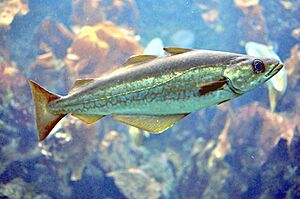Atlantic pollock facts for kids
Quick facts for kids Atlantic pollock |
|
|---|---|
 |
|
| Conservation status | |
| Scientific classification | |
| Synonyms | |
|
Gadus pollachius Linnaeus, 1758
|
The Atlantic pollock (scientific name: Pollachius pollachius) is a type of fish that lives in the sea. It belongs to the Gadidae family, which includes cod and haddock. In some places, it's simply called pollack, or sometimes European pollock. Other names for it include lythe and calig.
This fish is often found in the north-eastern parts of the Atlantic Ocean. This includes areas like the Bay of Biscay and the North Sea. Adult Atlantic pollock can grow quite large. They can reach up to 130 cm (51 in) in length and weigh up to 12.5 kg (28 lb). However, most often they are around 75 cm (30 in) long.
Contents
About the Atlantic Pollock
Where do Atlantic Pollock Live?
Atlantic pollock are known as benthopelagic fish. This means they live near the sea floor, but they can also swim higher up in the water. They tend to stay in one area and don't move around too much.
How Long do Atlantic Pollock Live?
These fish grow quickly but don't live for a very long time. The oldest Atlantic pollock ever recorded was 15 years old. They lay their eggs, a process called spawning, in the open ocean. However, scientists don't know exactly where all their spawning grounds are. One study in a fjord in Norway suggested they might also spawn closer to shore.
Fishing for Atlantic Pollock
Commercial Fishing
Atlantic pollock are important for fishing. They are often caught by accident when fishermen are trying to catch other types of fish. This is called bycatch. Records show that Atlantic pollock are mainly caught in three different areas. One area is in the northern North Sea and along the coast of Norway. Another is between the English Channel, the Irish Sea, and the French coast. The third area is in the waters near Spain and Portugal. Only a few thousand tonnes of Atlantic pollock are caught each year by commercial fishing boats.
Recreational Fishing
Atlantic pollock are also a popular fish for people who fish for fun. In Norway, it was estimated that people fishing for recreation caught about 100 tonnes of pollock in 2009. In France, recreational fishermen were thought to catch around 3,500 tonnes of pollock.


